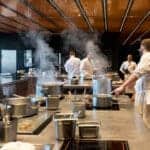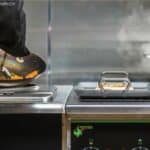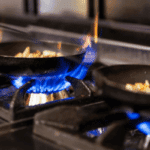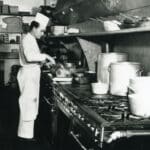Electrify commercial kitchens now to save your money, your health, and your planet
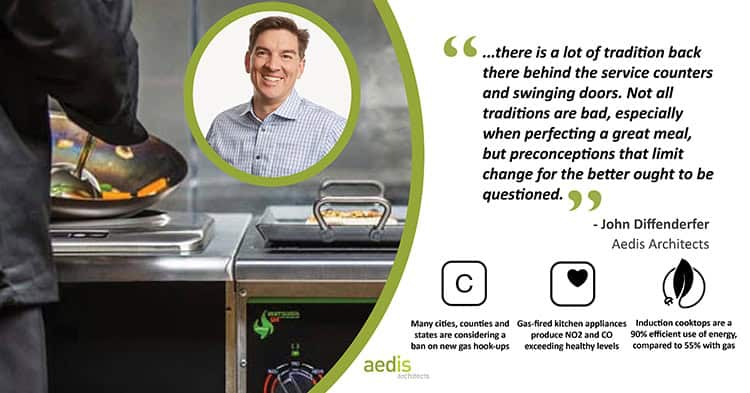
John Diffenderfer, Aedis Architects
July 2021
The road to reversing climate change is bumpy and the destination will be arrived at through both new behaviors and new technology. We will all have to trade in some habits and beliefs for some new and possibly uncomfortable ideas. As cities, counties and the states consider legislation to mandate the elimination of gas infrastructure in new construction, many commercial industries and their architects, engineers, developers, and builders are investigating the impact these new rules will have on their operations. As an architect that has designed several Zero Net Energy/Emissions buildings, I can unequivocally declare that the technology exists to decarbonize today, and it has existed for quite some time. So, what is the hold up? Short answer: economics and, simply put, change is hard.
One area that has felt heat in the debate recently is the commercial kitchen industry. The basic technology of the commercial kitchen has not really changed in the last half century, and it continues to be an unhealthy and dangerous place. Nevertheless, there is a lot of tradition back there behind the service counters and swinging doors. Not all traditions are bad, especially when perfecting a great meal, but preconceptions that limit change for the better ought to be questioned.
Need To Know:
- The California Energy Commission is considering its 2022 code cycle revisions to the California Energy Code which include the banning of new gas connections to all new construction (CA added a quarter of a million new gas customers to the State since 2013.
- Fossil fuel kitchen appliances emit pollutants that are harmful to your health. 12 million Californians with gas stoves are breathing NO2 levels above levels that would be illegal outdoors, and nearly 2 million are breathing illegal levels of carbon monoxide.
- 30 cities and counties in California adopted local building codes and ordinances encouraging all-electric new construction, with 50 more considering it.
- PG&E, California’s largest rate-payer utility, serving 40% of the State’s gas customers, has formally written in support of the CEC’s proposed energy code changes, including electrification of new construction.
The conclusion from the facts above is that electrification is coming, and it is a good thing, both for the environment, and for our health. I recognize that from some perspectives it is does not always seem so. It will mean capital investment, and it will mean operational change. What about all the new equipment we must buy? Will I have to retrain my crew, learn new methods, and create new menus? One large kitchen manager I spoke to declared, “The challenge is that it’s a different way of cooking and it takes getting used to”. By 2035, all kitchens will be electric, gas will not be allowed, so it is not a matter of if, but when. My contention is that once the transition has been made, the worries will be distant memories, and we may even chuckle at the thought of the arguments we once made.
PG&E established the Food Service Technology Center more than three decades ago to promote energy efficiency in kitchen design. It is a place to test-drive kitchen equipment before you buy, and the Center offers seminars, reports, and consulting to operators and designers. There is myth that persists claiming that gas stovetops and ovens are preferred by chefs because they heat faster and more evenly than electric. It turns out that with a little digging, this is not entirely true. I found a 2011 video where Gordon Ramsey admits that he liked both technologies, and an article where Bruce Mattel of the Culinary Institute of America is quoted saying that he found them to be completely comparable. Most equipment today is available in a gas or electric version, with no change needed in cooking techniques. The real exception is the gas stove. Here, we encounter the “different ways of cooking” that some resist, even though induction stoves a) do not get (nearly as) hot or heat the room, b) cost about the same, less when you consider the gas piping, and c) do not emit the NO2 and CO that is so harmful. Aedis works with many California School Districts, and student and staff health is a significant economic factor in our schools: when a child stays home, the school loses “ADA” (average daily attendance) which directly affects operational funding. Studies have shown that children are even more sensitive to the effects of pollutants from gas cooking than adults. A 2013 study in the International Journal of Epidemiology showed that children living in a home with a gas cooking stove have a 42% increase of current asthma risk, and 24% increase of asthma in their lifetime.
“Powerful, immediate, precise, effective, practical … the qualities of induction”, Author/Chef Thierry Molinengo, Paris.
Induction cooking is inherently safer because there is no open flame and are not left “hot” when not in active use. There are no gas leaks, and spilled oil will not lead to a bigger fire. Speaking of spills, clean-up is easier. The biggest downside: you (may) have to buy new pots and pans. Your cookware must have magnetic properties, like cast iron (enameled) and stainless steel. Le Creuset, All-Clad, and many others make induction-ready cookware. Some chefs are accepting the challenge of the all-electric kitchen. “What I realized when working with induction was that there were some things that we did in the traditional kitchen that was just wasteful,” says Chef Chris Galarza, the owner and culinary sustainability consultant for Forward Dining Solutions LLC. Chris helped build and run the Chatham University Eden Hall’s all-electric kitchen (the world’s first ZNE campus). “[Traditionally,] when I know something off the line is coming for me to sauté eventually, I’ll have pans on the burners on low, so they are already hot, and I am all ready to go.” With induction cooking, Chris learned that he just did not need to do that. With a cold pan, he can still cook faster than the chef with the preheated pans – AND he is able to demonstrate savings on fuel, and cooling costs. At Eden Hall, the ventilation systems are controlled and interconnected with the cooktops, so they only run when cooking is happening. Energy AND air quality are monitored in real time. Galarza recognized a 9-month payback, despite spending 3 times the first cost of a traditional kitchen. He credits reduced energy savings and improved operational efficiency.
If You Operate a Commercial Kitchen:
- Specify electric equipment for everything — If you are considering building a new commercial kitchen or renovating an existing one soon, avoid the gas fired equipment and opt instead for electric alternatives (water heaters, ovens, and induction stoves, for instance).
- Think creatively about efficiency and sequencing – All chefs learn the term “mise en place”, which means to get things set up before you cook. With induction cooking, this becomes a must-do activity. Old habits can be hard to break, but chefs are used to learning new tricks whenever they enter a new environment, so this should not be any different.
- Upgrade your electrical panels – Sooner or later, you will be replacing your equipment, or doing a deeper modernization on your facility. When you opt for electric equipment, your load will go up, and this may exceed your capacity. Upgrading your panels requires a lengthy application process through your local jurisdiction, and a lengthier one through your utility company. Hire a consultant, do the calculations, and start now.
When Robert Kenny, Vice President of PG&E, wrote “PG&E believes a multi-faceted approach is needed to cost-effectively achieve California’s broader economy wide long-term GHG reduction objectives” he recognized that it is not just the job of the utility company and the regulators to policy our way out of climate catastrophe danger, but a job for all of us. We must look at what we accept as true and inviolable and consider that there could be another way to operate. Frankly, as an unsinkable optimist, I prefer to think of this as an opportunity to invent something new: a process or product. Doesn’t that sound like more fun, anyway?
References:
GreenePrincipal, S. (n.d.). PG&E agrees: California should go all-electric in new construction. Retrieved January 02, 2021, from https://www.greenbiz.com/article/pge-agrees-california-should-go-all-electric-new-construction
Lin W, Brunekreef B, Gehring, U. Meta-analysis of the effects of indoor nitrogen dioxide and gas cooking on asthma and wheeze in children. Int J Epidemiol. 2013; 42:1724–1737.
Photo Credits:
Liz Seabrook
Richard Perry/The New York Times
Michael Grimm/Business Insider
https://www.loire.fr/jcms/lw_1169100/premier-service-a-ouches-pour-la-maison-troisgroschris
https://forwarddiningsolutions.com/about
https://restaurant-ingthroughhistory.com/2016/06/27/cooking-with-gas/


